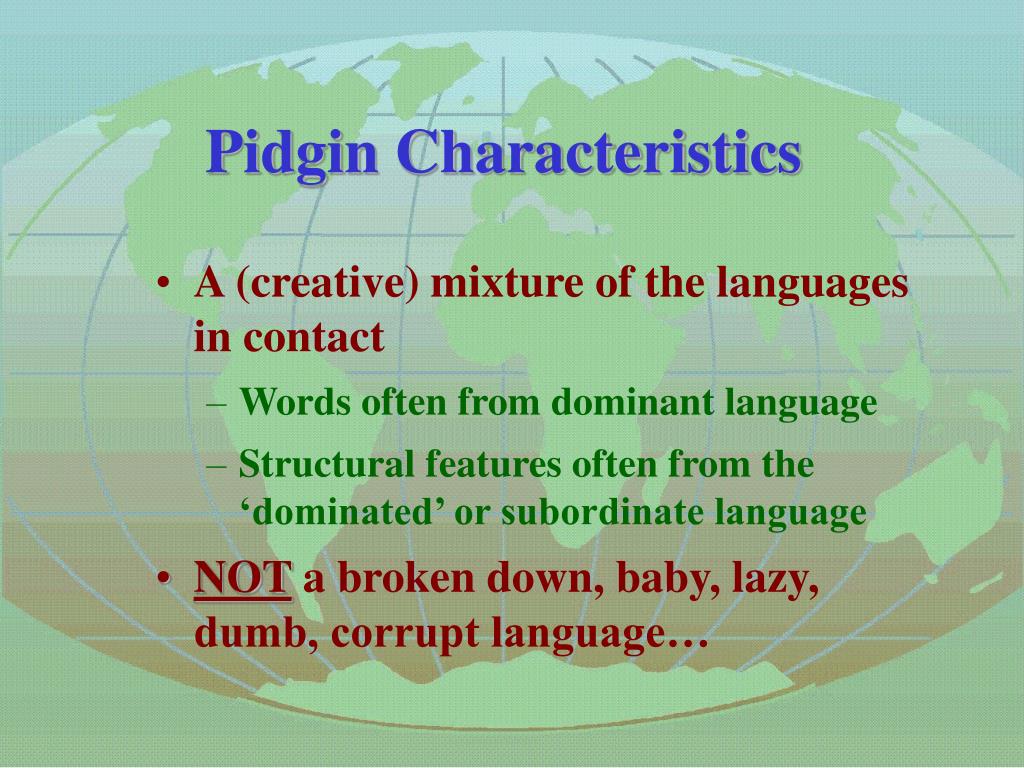

By combining different languages, the grammar becomes as basic as possible to decrease confusion between languages that feature sometimes radically different grammatical structures, like English and Japanese. In pidgins, the code-switching can be much more complex than a simple phrase, as the entire language is comprised of combining different languages and creating new words in the process.Ĭode-switching is crucial for pidgin languages, since combining languages is the basis of pidgin. For example, saying “Hasta la vista, baby” is a basic form of code-switching, since words in both English and Spanish are being used. Linguistically, code-switching is a characteristic in which an individual or group will alternate and mix languages as they see fit. With the alternating usage of first and second languages, code-switching is a common feature of pidgin languages. Other basic pidgin languages eventually evolved, resulting in distinct languages like Louisiana Creole and Hawai’i Creole, also known as Pidgin English, which was created by Asian, Hawaiian, European, Filipino, and Puerta Rican laborers on Hawaiian sugarcane plantations. The most widely used form of a creole language is Haitian Creole, with over seven million speakers throughout the world. Pidgins, which start as a simpler form of communication, can evolve over generations into a creolized language, which features a much more extensive vocabulary and more well-defined grammatical structures. With extended use over time, a pidgin language develops and becomes a common mode of communication.ĭue to the simpler grammatical structure and limited vocabulary, pidgins are usually secondary languages, used in specific scenarios and groups, while a primary language like French or English is used more frequently. Pidgins are a mixture of words from different languages, and feature a simpler grammatical structure and smaller vocabulary. Pidgins are languages that grow out of necessity when groups of people that don’t share a common language must interact with each other. Since pidgin languages are popular in many areas of the world, it’s important to understand the characteristics of pidgins, and how some are using the languages to localize communications with these cultures. In reality, pidgins are a historically rich testament to human ingenuity, a natural evolution of languages, and the need for communication. This has caused some to categorize pidgin languages as incorrect or a sub-standard form of major languages.

Findings from new CPE sources also suggest a need for re-examining the historical connections between CPE and other Pidgin English varieties of the Pacific region.To some, pidgin languages can initially sound like a broken variation of more commonly spoken languages, and assumptions are made that pidgin speakers are using slang. It will be argued that the emergence of long is a case of multiple etymologies which involves the recombination of phonological, syntactic and semantic features from both English and Cantonese. The creation of long does not conform to the traditional thesis of simply taking the phonetic form from the lexifier language and deriving the grammar from the substrate language. It will be shown that a substantial part of the syntax and semantics of long can be attributed to substrate transfer of a corresponding Cantonese morpheme tung4 'with'. A second function of long is to mark coordination. Long is used to indicate a range of semantic roles: comitative, benefactive, malefactive and source. The significance of long is that it is highly multifunctional and semantically versatile.

This paper examines the origins and grammatical properties of a preposition in Chinese Pidgin English – long – which has not received much discussion.


 0 kommentar(er)
0 kommentar(er)
